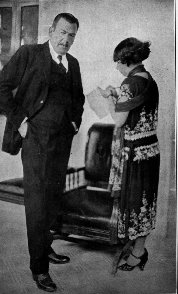
Born September 25, 1877 in Guaymas, Sonora, he studied to be a teacher
in Hermosillo. He was a teacher and a journalist. When Francisco I. Madero
became president, he ran for federal deputy, losing to Adolfo de la
Huerta.1
He served as an official in Agua Prieta from which he joined the Mexican
Revolution after Madero was assassinated in 1913, fighting with
Alvaro Obregón
against Pascual Orozco
and Victoriano
Huerta. He quickly became a colonel. In
1918, he was elected governor of
Sonora. President Venustiano
Carranza appointed him as Secretary of Industry, Commerce, and
Labor. He was the principal author of the Plan de Agua Prieta, the justification
for the overthrow of Carranza in 1920. De la Huerta became interim president and
Calles became Secretary of War. When Obregón assumed the presidency later
that year, Calles became his Secretary of Government. In 1924, he was elected
President of the Republic after he and Obregón defeated the de la Huerta
Rebellion in 1923.
As president he faced the problem of continuing to rebuild
the nation after the devastating Revolution. He built a powerful national army
and eliminated most of the private armies that local leaders (caudillos) used to
dominate their areas and disobey the national government. His regime built
schools and trained teachers and conducted literacy campaigns. It was
during his administration that the central bank, the Banco de México, was
created.2
Agricultural and ejidal banks3
were created. He distributed distributing some 3.2 million hectares of land.
He began a road building campaign and started irrigation works. He was a friend
of the U.S. Ambassador, Dwight W. Morrow. Some said he took orders from Morrow.
Calles was friendly towards US business interests. He was backed by Luis Morones'
Confederación Regional Obrera Mexicana (CROM); both got rich. Many had
homes in Cuernavaca on a street local wags referred to as the street of the
forty thieves.
He is most noted for his battle with the Roman Catholic
Church and its partisans who launched the Cristero
Rebellion (1926-29). He insisted that the clergy act morally and obey the
Constitution, which they did not want to do because it was anticlerical.
Archbishop José Mora y del Río stated publicly that the Church would not
obey the law. Calles responded by enforcing the law--closing monasteries and
convents, deporting foreign clergy, banning public religious demonstrations, and
closing church schools. The army fought to defend the government but the end of
the rebellion was finally negotiated in 1919, after Calles had left
office.
Obregón was elected president in 1928 after he and Calles
had the constitution amended to allow reelection and the term extended to six
years, but Obregón was assassinated by a Catholic fanatic in July, 1928.
Congress named Emilio Portes
Gil as interim president. Calles organized the National Revolutionary
Party in 1929 which ruled the country, under different names, until 2000. The
PNR was an agreement among the various leaders in the nation--state
political bosses, national politicians, labor union leaders, large farmers,
businessmen, military officers, etc,--to choose the presidential candidate and
other political officers among themselves and then present a united front to the
nation. In short, he created a national political machine.
Historians generally refer to the 1928-1936 as the Maximato,
a period when Calles ruled behind the scenes. Pascual Ortiz Rubio
was elected as the PNR candidate in 1929 against José
Vasconcelos but resigned in 1930. General Abelardo Luján Rodríguez, who had extensive business
holdings in Baja California, became president. Calles had become so corrupt,
conservative, and anti-worker that the PNR ran Lázaro
Cárdenas, a liberal governor of Michoacán and a Revolutionary general for
president. Cárdenas
exiled Calles in 1936.
He returned from exile in 1941 as Cárdenas
sought national unity during World War II. He died in 1945.
1 De la Huerta would also become President of Mexico.
2 The author of the law establishing the bank was Manuel Gómez Morín who would later found the Partido Acción Nacional.
3 Ejidos were traditional community-owned farms. Ejidatarios had the right of usufruct but lost it when they left the ejido. The ejido was a popular form of land tenancy after the Revolution because it helped peasants get access to land.
Don Mabry
120103